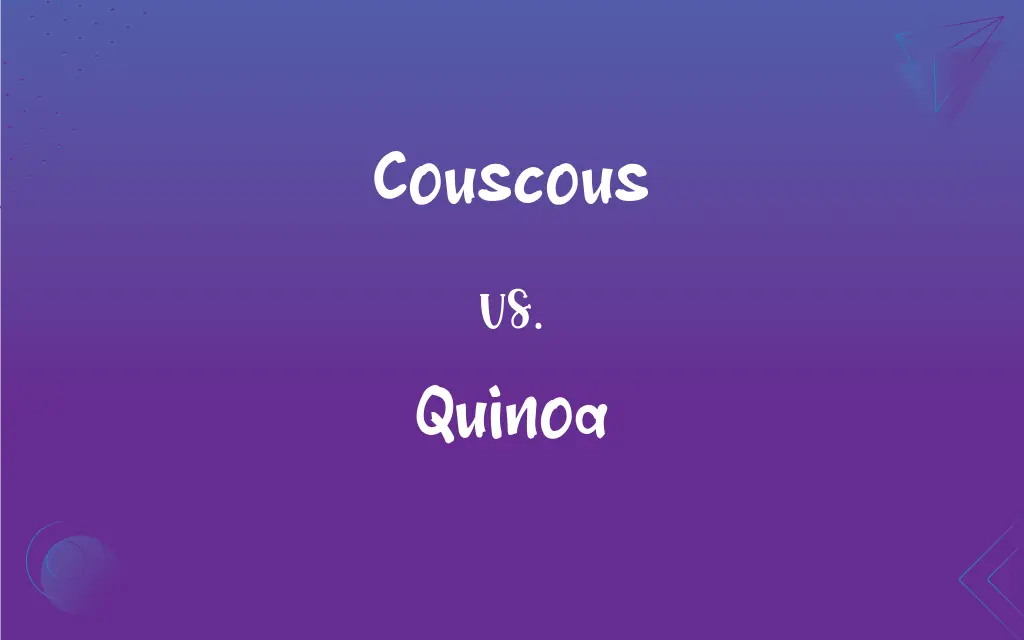Couscous vs. Quinoa: What's the Difference?
Edited by Aimie Carlson || By Harlon Moss || Updated on October 26, 2023
Couscous is a North African pasta made from semolina; quinoa is a South American seed, often used like a grain.

Key Differences
Couscous and quinoa, while often used in similar culinary contexts, originate from different parts of the world and have distinct nutritional profiles. Couscous is a traditional North African dish made from semolina wheat, which makes it a type of pasta. Quinoa, on the other hand, is a South American seed from the Chenopodium quinoa plant and is often referred to as a pseudo-cereal. While couscous is derived from wheat and thus contains gluten, quinoa is naturally gluten-free, making it suitable for those with gluten intolerances.
In terms of preparation, couscous and quinoa require different cooking times and methods. Couscous is typically steamed or can be quickly rehydrated with hot water or broth, making it a fast option for meals. Quinoa requires rinsing to remove its natural coating, saponin, which can be bitter, and it's usually cooked in boiling water, similar to rice, with a longer cooking time compared to couscous. This difference in preparation reflects the unique nature of couscous as a form of pasta and quinoa as a seed.
Nutritionally, couscous and quinoa present different health benefits. Couscous, being made from semolina wheat, is primarily a source of carbohydrates with a moderate amount of protein and minimal fat. Quinoa is renowned for its high protein content, including all nine essential amino acids, making it a complete protein, which is rare among plant-based foods. Quinoa also boasts higher fiber content and a range of vitamins and minerals, making it a nutritionally dense option compared to couscous.
The texture and flavor profiles of couscous and quinoa differ significantly. Couscous has a light, fluffy texture and a relatively mild flavor, making it a versatile backdrop for a variety of dishes. Quinoa has a slightly nutty taste and a unique texture that's both chewy and crunchy. These differences in texture and taste influence how couscous and quinoa are used in culinary practices, with couscous often serving as a base for stews and quinoa being used in salads, bowls, or as a rice substitute.
Couscous and quinoa, while appearing similar, hold distinct cultural significance. Couscous is deeply rooted in North African cuisine, often served with tagines, stews, and vegetables. Quinoa, once a staple food for the Inca civilization, has gained global popularity due to its health benefits. Despite their different cultural origins, both couscous and quinoa have become popular globally, embraced for their versatility and unique characteristics in cooking.
ADVERTISEMENT
Comparison Chart
Type
Pasta made from semolina
Seed, often used like a grain
Origin
North African
South American
Cooking Method
Steamed
Cooked in water like rice
Nutritional Profile
Lower in protein, vitamins
Complete protein, rich in nutrients
Culinary Uses
Salads, stews, side dishes
Salads, soups, side dishes, baking
ADVERTISEMENT
Couscous and Quinoa Definitions
Couscous
Pasta from semolina flour.
She made a delicious vegetable stew with couscous.
Quinoa
Gluten-free ancient seed.
Quinoa is a great choice for gluten-free diets.
Couscous
North African staple food.
Couscous is a must in traditional Moroccan dishes.
Quinoa
Complete protein source.
Vegans often use quinoa as a protein source.
Couscous
Tiny granules of durum wheat.
He sprinkled some herbs over the steamed couscous.
Quinoa
Versatile in cooking.
He added quinoa to his morning smoothie bowl.
Couscous
Quick-cooking and versatile.
For a quick meal, she opted for couscous salad.
Quinoa
South American origin.
Quinoa has been a staple in Andean cuisine for centuries.
Couscous
Often steamed and fluffed.
The couscous was perfectly fluffy and light.
Quinoa
Nutrient-rich pseudo-grain.
She substituted rice with quinoa for extra protein.
Couscous
A pasta of North African origin made of semolina or other grains, formed into small pellets and usually steamed.
Quinoa
A goosefoot (Chenopodium quinoa) native to the Andes and cultivated for its edible seeds.
Couscous
A North African dish consisting of this pasta served with stewed vegetables or meat.
Quinoa
The seeds of this plant, used as food.
Couscous
A pasta of North African origin made of crushed and steamed semolina.
Quinoa
A goosefoot (Chenopodium quinoa) native to the Andes and cultivated for its edible seeds.
Couscous
A kind of food used by the natives of Western Africa, made of millet flour with flesh, and leaves of the baobab; - called also lalo.
Quinoa
The high-protein dried fruits and seeds of this plant, used as a food staple and ground into flour.
Couscous
A spicy dish that originated in northern Africa; consists of pasta steamed with a meat and vegetable stew
Quinoa
The seeds of a kind of goosewort (Chenopodium Quinoa), used in Chili and Peru for making porridge or cakes; also, food thus made.
Couscous
A pasta made in northern Africa of crushed and steamed semolina
FAQs
Can couscous be eaten cold?
Yes, couscous can be served cold in salads.
Is couscous gluten-free?
No, couscous is not gluten-free as it's made from wheat.
What dishes use couscous?
Couscous is used in salads, stews, and as a side dish.
What is couscous made from?
Couscous is made from semolina wheat.
Is quinoa good for weight loss?
Quinoa can be part of a healthy diet for weight loss due to its high protein and fiber content.
What are the health benefits of quinoa?
Quinoa is high in protein, fiber, vitamins, and minerals.
Is quinoa keto-friendly?
Quinoa is higher in carbs and may not be suitable for a strict keto diet.
Is quinoa a grain?
Quinoa is a seed, but often used like a grain.
What is the origin of couscous?
Couscous originates from North Africa.
Does couscous have any health benefits?
Couscous provides carbohydrates and is low in fat.
Is couscous easy to digest?
Couscous is generally easy to digest.
Does couscous contain protein?
Couscous contains some protein, but it's not a complete protein source.
Is couscous good for diabetics?
Couscous is high in carbohydrates and should be consumed in moderation by diabetics.
How long does cooked quinoa last?
Cooked quinoa can last in the fridge for 3-5 days.
Can quinoa be used in baking?
Yes, quinoa can be used in baking, such as in bread or muffins.
What are the different types of quinoa?
There are several types, including white, red, and black quinoa.
How do you cook quinoa?
Quinoa is cooked by boiling in water, similar to rice.
Can couscous be reheated?
Yes, couscous can be reheated.
What does quinoa taste like?
Quinoa has a nutty, earthy flavor.
Can quinoa be eaten raw?
Quinoa should be cooked as raw quinoa can be hard to digest.
About Author
Written by
Harlon MossHarlon is a seasoned quality moderator and accomplished content writer for Difference Wiki. An alumnus of the prestigious University of California, he earned his degree in Computer Science. Leveraging his academic background, Harlon brings a meticulous and informed perspective to his work, ensuring content accuracy and excellence.
Edited by
Aimie CarlsonAimie Carlson, holding a master's degree in English literature, is a fervent English language enthusiast. She lends her writing talents to Difference Wiki, a prominent website that specializes in comparisons, offering readers insightful analyses that both captivate and inform.































































